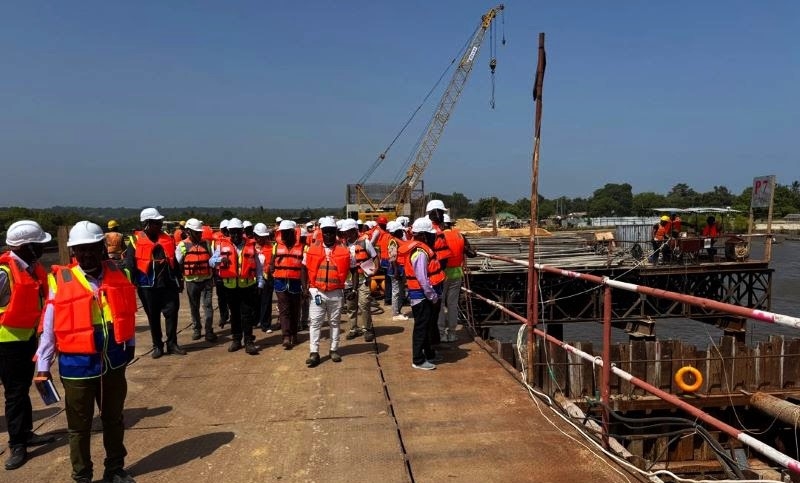The African Development Bank has committed USD 2.5 billion to the development of priority infrastructure projects in Tanzania.
The Chief Transport Engineer at the African Development Bank (AfDB) Tanzania Country Office based in Dar es Salaam, Engineer Mumina Wa-Kyendo, disclosed that the funding is for priority infrastructure projects, with more than 70 percent of the funds being allocated to transport corridors and facilities including roads, railways and airports.
Projects benefiting from the funds include the Tanzanian stretch of the multinational Tanzania and Kenya road network.
This is the 400 kilometers Bagamoyo – Pangani – Tanga – Horohoro onwards to Lunga Lunga – Mombasa – Malindi on the Kenyan side a road that is currently under construction in both countries and which forms part of the Coastal Transport Corridor of East Africa that stretches from Lamu in Kenya to Mtwara in Tanzania.
The AfDB had set aside USD 100 million for the Tanzanian stretch of the multinational road, which after completion is expected to ease the movement of people and goods along the East African coast by cutting the travel distance between Dar es Salaam and Tanga by about 90 kilometers, translating to a time saving of over one hour.
It will also mean that travelers will avoid the Central Corridor and instead access Tanga via Bagamoyo and Pangani towns.
Other priority projects being implemented through AfDB funding include the Nyakanazi – Kabingo – Kasulu – Kumnazi road in western Tanzania, Mawala – Masasi road in southern Tanzania, Tabora – Kigoma – Uvinza railway that will go all the way up to Musongati in Burundi, and the Msalato International Airport in Dodoma.
Engineer Wa-Kyendo made the revelations in Tanga at the end of a two-day inspection and supervision mission of the Bagamoyo-Pangani-Tanga stretch by a multi-level team of experts from the East African Community (EAC) Secretariat, Ministry of Works and Transport from Tanzania, Ministry of Roads and Infrastructure from Kenya, Tanzania National Roads Agency (TANROADS), Kenya National Highways Authority (KENHA), the Northern Corridor Transit and Transport Coordination Authority (NCTTCA) and Central Corridor Transit Transport Facilitation Agency (CCTTFA).

The inspection team was led by Engineer Robert Achieng, the Director of Infrastructure at the EAC Secretariat, the Tanzanian team was led by Eng. Japherson Nnko, the Director of Projects at TANROADS, and the Kenyan delegation by Eng. Kimeli Kipchumba, the Roads Secretary at the Ministry of Roads and Transport.
Engineer Robert Achieng who was speaking on behalf of the EAC Secretary General, Veronica Nduva, said that the primary focus of the Community was the development of ten multinational corridors that form the East African Road Network.
In particular the three principal corridors, including the Central Corridor (Dar es Salaam-Morogoro – Dodoma – Singida – Nyakanazi – Rusumo/Rusumo – Kigali – Rubavu / Nyakasanza – Kabanga/Kobero – Bujumbura-DRC), Northern Corridor (Mombasa-Nairobi-Malaba-Kisumu-Kampala-Kigali-Juba-DRC) and the Lamu Port – South Sudan – Ethiopia (LAPSSET) corridor.
Achieng informed the meeting that the EAC was currently conducting a Feasibility and Funding Options Study for the proposed Kenya/Uganda multinational Kisumu – Busia / Jinja – Kakira – Malaba (including Busitema – Busia Spur) Expressway, which will ease the movement of goods and persons along the Northern Corridor.
Eng. Achieng said that the bloc had prioritized the development of roads and railways along the key transport corridors, adding that developments were being funded through Partner States’ own source revenues and official development assistance from the AfDB and other development partners.
He disclosed that the report of the inspection mission would be tabled before the next meeting of the EAC Sectoral Council of Transport, Communications and Meteorology for consideration and guidance on policy issues arising.
The AfDB official said that the bank’s funding was conditional upon the efficient implementation of projects, which is key to unlocking additional funding with the bank takes seriously the development of transport infrastructure which is a key facilitator to trade and integration of countries, even as he called for closer cooperation and sharing of best practices between the Northern and Central Corridor transit and transport coordination authorities.
He singled out the Arusha-Namanga-Athi River and Arusha – Holili/Taveta – Voi roads as examples of projects that were properly implemented (within time and budget).
“We need to have a region where transport works, put in place roads and railways of the best standards. This is because national and supra-national interests sometimes conflict,” he said.
He observed that at the moment, it is not clear which entity is in charge of the corridor linking the Central and Northern corridors, adding that this is a gap that needs to be addressed with utmost urgency by the EAC Partner States.

